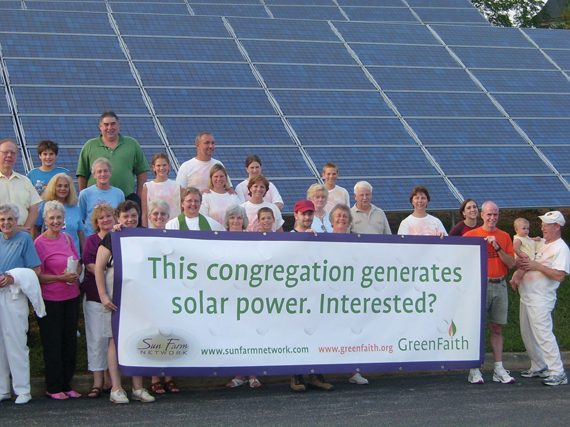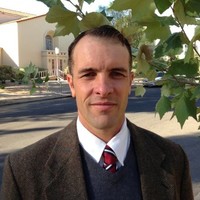On first blush, there doesn’t appear to be much in common between those placing their faith in markets and those putting faith in the divine. Wasn’t it the moneychangers, after all, who incurred the physical wrath of an otherwise pacifist Jesus? The Qu’ran notes with little room for quibbling, “They who hoard up gold and silver and spend it not in the way of Allah, unto them give tidings of a painful doom.” The Buddhist Dhammapada says, “Not by a shower of coins does contentment arise.”
So much for heavenly endorsement of the price-conscious. Yet GreenFaith, a religious interfaith coalition, takes a less critical view of the role of markets, particularly as they bear on environmental resources. Fletcher Harper and Stacey Kennealy, two graduates of PERC’s Enviropreneur™ Institute (‘07 and ‘10 respectively) believe that the overarching market concept shaping GreenFaith’s work has been the idea of getting the incentives right. “People think that in the religious sector, belief and good intentions are what fuel people’s behavior,” said Harper, Executive Director at GreenFaith. “Our experience is that beliefs and intentions alone fail to get the job done.”
This revelation may be the key to GreenFaith’s success. Its mission to inspire, educate, and mobilize people of diverse religious backgrounds for environmental leadership is informed by the recognition that decisions are rarely reached in a vacuum. GreenFaith has an advantage, admittedly, in leveraging the shared beliefs of the world’s great religions—that protecting the earth is a religious value, and that environmental stewardship is a moral responsibility. But simply insisting that people “do what’s right” doesn’t capture the full measure of GreenFaith’s work; the group calls for their members to address the mundane as well as the celestial. Values need to be specific and actionable.
SAVING MONEY
One of GreenFaith’s primary arguments for sustainable stewardship is the market-centered concept of saving money. Few activities are as earth-friendly as reducing wanton waste of costly resources. Temple Beth Rishon, for example, a successful case study under GreenFaith’s popular Certification Program, saved $34,000—with the small up-front investment of $500—by adhering to a set of energy-saving principles that GreenFaith helped implement.
We have seen time and time again that it creates significant environmental and financial benefits, and that it helps houses of worship become revitalized.
Through the Certification Program, houses of worship undergo a two-year process through which they integrate environmental themes into their worship services and religious education, their facility management, and their advocacy—focusing on issues that create a healthier environment for low-income communities. Participating faith communities also educate their members about adopting sustainable consumption habits, and carry out multi-generational activities and programs on the environment with institutions from different religious traditions.
The goal is to address “greening” comprehensively and holistically. “This is a big commitment for participating institutions,” said Stacey Kennealy, director of the Certification Program, “and it pays off in a big way. We have seen time and time again that it creates significant environmental and financial benefits, and that it helps houses of worship become revitalized. For example, younger members of temples, churches, and mosques often get more involved when they see their congregation engaging the environment. But it took us quite a while to understand how to market those benefits effectively.”
Initially, GreenFaith marketed its Certification Program as an environmental leadership program. Over time, however, the marketing message has focused increasingly on the benefits of attracting and engaging younger members and financial savings, with environmental benefits as the third point of emphasis. “We realized that for the top leaders in most faith-based sites, the overall wellbeing of their congregation—its vitality, its ability to attract new and younger members, and its financial viability— represented the top-tier concerns,” said Harper. “We’ve begun to market the Certification Program as an answer to these challenges.”
This approach is having results. In the past year, GreenFaith has entered relationships with three national denominations that are promoting the Certification Program to their member congregations nationwide. “These denominations recognize that the program is a way that they can help their congregations grow, both financially and as a community,” said Kennealy. “By identifying our customers’ primary needs, we’ve been able to reach a larger audience.”
GreenFaith has also applied lessons gained at the Enviropreneur Institute in shaping the staff compensation structures in several of its programs. During 2010, for instance, GreenFaith was hired by PSE&G—one of the largest utility companies on the East Coast—to enroll moderate- income households into a home energy audit program. GreenFaith established a compensation structure through which representatives were paid for every household they enrolled. The group also established a referral program through which homeowners could receive a gift card for each successful referral they made. GreenFaith involved members of more than 150 urban congregations in the outreach effort. The results? More than 4,000 homes enrolled in the program over a 10-month period—results superior to those that PSE&G had experienced from their traditional billboard, bus stop, and bill insert advertising.
INCENTIVES MATTER
Recognizing incentives is clearly an important pillar of an economic way of thinking and a critical aspect to free market environmentalism. For many, incentives exist only as quantifiable metrics: cash payments, dividends, and return on investment. For others, incentives only exist in the ethereal sense: obligation, avoidance of censure, moral duty. Green- Faith does a remarkable service by demonstrating that good things occur if incentives can be looked at from both perspectives simultaneously.
GreenFaith is applying the psychology of incentives to their 2012 residential solar program, a partnership with solar developer AP Solar. Through this partnership, GreenFaith will identify candidates to have a solar array installed on their home at no cost, and purchase the electricity generated by the solar array at a discount to the utility price.
In the end, GreenFaith isn’t just about teaching people that God wants a healthy environment,” said Harper. “It’s about mobilizing the faith-based sector—one of the largest social networks in the country—to make it actually happen. PERC has helped us understand new tools and perspectives on how to achieve this goal. We’re very grateful.
GreenFaith will employ commission-motivated representatives who will organize “solar screening events” throughout a number of New Jersey religious institutions. At these events, homeowners will have their homes screened initially via satellite photo, and the GreenFaith representative will be paid for each home that “goes solar” through the event. In addition, to incentivize the institution to publicize the event widely, GreenFaith will make a contribution to the congregation for each “solar home” that results from their event. “Initially, we set the incentive level for the host sites relatively low,” said Harper. “But then we realized that to reach the volume that we want, we need their enthusiastic support, so we increased it substantially.”
GreenFaith and AP Solar are launching the program in February, and hope to have at least 500 solar installations completed by the end of the year. “AP Solar came to us because they wanted to generate higher sales volume as efficiently as possible,” said Harper. “We’re approaching this as aggressively as we can.”
MERGING MARKETS & FAITH
All this sounds suspiciously businesslike, quite unlike the idealism so common in the nonprofit sector. But GreenFaith’s national reputation for encouraging environmental leadership at churches, mosques, synagogues and other houses of worship all over the country speaks to the value of the approach. “It’s been an interesting cross-cultural experience to combine free-market and faith-based principles on the environment,” said Harper. “While there are a number of ways in which we’ve seen markets fail to protect the environment, we also recognize that market and business principles are extremely powerful tools to create positive environmental change.”
“In the end, GreenFaith isn’t just about teaching people that God wants a healthy environment,” said Harper. “It’s about mobilizing the faith-based sector—one of the largest social networks in the country—to make it actually happen. PERC has helped us understand new tools and perspectives on how to achieve this goal. We’re very grateful.”
It is said that it is “easier for a camel to go through the eye of a needle than for a rich man to enter heaven.” This may indeed be true; laboratory tests so far have been inconclusive. But the larger point is, of course, that a single-minded devotion to financial incentives can be ruinous to the soul. GreenFaith helps remind us that our motivations ought to be more broadly understood.
For more information: www.greenfaith.org




